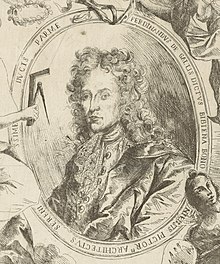Ferdinando Galli-Bibiena

Ferdinando Galli-Bibiena (18 August 1657 – 3 January 1743),
Biography
Bibiena was born on 18 August 1657 at Bologna.[1] He was the son of painter Giovanni Maria Galli (1625–1665), and he studied painting under Carlo Cignani and architecture under Giulio Trogli, called il Paradosso.[3] On the recommendation of Cignani, Bibiena entered into the service of the duke of Parma and also worked for the Farnese dynasty at Piacenza over a period of 30 years. His main work during this time was the garden and villa of Colorno, but he also earned a reputation for his scenic designs and began working for the theatre.[3]
In 1708, Bibiena was called to Barcelona to organize the decorations in connection with the wedding festivities of the future Holy Roman emperor Charles VI.[3] Following his accession, Bibiena traveled to Vienna, where he worked on designs of scenery and decorations for court festivities and opera performances.[4] In his decorations for the theatre and festivities, Bibiena replaced the central (vertical) axis with a diagonal axis, introducing an angular perspective.[1]
In the competition to select a design and architect for the construction of the
In 1731, Bibiena built the royal theatre of Mantua (which burned down 50 years later, in 1781).[3] He produced several books, including:[3]
- L'Architettura civile (1711; "Civil Architecture"), later reissued under various titles
- Varie opere di prospettiva (1703–1708; "Various Works of Perspective").
Past the age of 86, Bibiena died on 3 January 1743.[1]
Family
The Galli-Bibiena family derives its name from the
Using the highly ornate style of late Baroque sculpture and architecture, the members of the Galli-Bibiena family produced a series of theatrical and other designs that are exceptional for their intricate splendour and spacious proportions achieved by detailed perspective.[3] Among their followers was Francesco Zinani of Reggio Emilia.[6]
From about 1690 to 1787, eight Bibienas designed and painted for many of the courts of Europe with intricate settings for
Among his followers or artists in his studio was Domenico Francia.[citation needed]
See also
Notes
- ^ a b c d e "Galli-Bibiena, Ferdinando" (dates, Farnese dynasty, to Barcelona for Karl VI),Encyclopedia of Austria, 2006, aeiou.iicm.tugraz.at webpage aeiou-FerdinandoGBibiena Archived 30 December 2012 at archive.today.
- ^ a b "Ferdinando Galli Bibiena Online" (overview), John Malyon, Artcyclopedia, 2005, Artcyclopedia.com webpage Artcyc-FBibiena.
- ^ a b c d e f g h i j k "Bibiena, Galli da, Family" (history),Encyclopædia Britannica Online, 18-November-2006, Britannica.com webpage:EB-Bibienas.
- ^ Caimi, Antonio (1862). Delle arti del designo e degli artisti nelle provincie di Lombardia dal 1777–1862. Milan, Italy: Presso Luigi di Giacomo Pirola. pp. 112–113.
- ^ Caimi, page 113
- ^ Boni, Filippo de' (1852). Biografia degli artisti ovvero dizionario della vita e delle opere dei pittori, degli scultori, degli intagliatori, dei tipografi e dei musici di ogni nazione che fiorirono da'tempi più remoti sino á nostri giorni. Seconda Edizione.. Venice; Googlebooks: Presso Andrea Santini e Figlio. p. 1106.
References
- A. H. Mayor, The Bibiena Family, 1940.
External links
- Architectural and ornament drawings : Juvarra, Vanvitelli, the Bibiena family, & other Italian draughtsmen, an exhibition catalog from The Metropolitan Museum of Art (fully available online as PDF), which contains material on Galli-Bibiena (see index)
